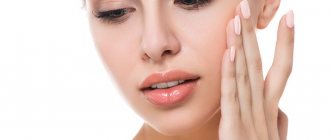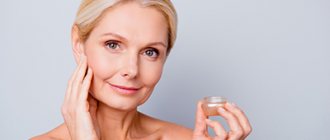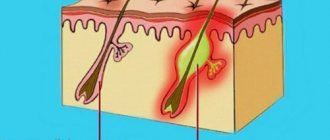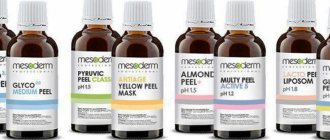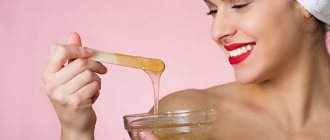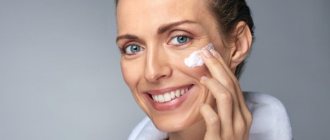Features of care for problem skin
Cleansing. Wash your face with warm water twice a day with foam, gel or lotion (for example, “Clean Line” deep-action cleansing gel). They contain anti-inflammatory components: zinc, chamomile, mint. After washing, wipe your face with a cotton pad soaked in toner or lotion. “Clean Line” facial lotion against blackheads based on zinc, chamomile and aloe vera helps tighten and cleanse pores. To remove makeup, use products without alkaline components that irritate the epidermis. Use micellar water - a safe product for delicate skin care and cleansing.
To even out skin tone and provide deep cleansing of pores, use scrubs that do not contain rough abrasive particles. Remember that even soft scrubs are recommended to be used no more than twice a week.
Hydration. Why does even oily skin need hydration? The fact is that excessive sebum production is a consequence of dehydration. The sebaceous glands begin to actively work to compensate for the lack of moisture. To moisturize your facial skin, use fluid creams with a light texture: they will not clog pores. The composition of such creams includes hydroxy acids (salicylic, malic, lactic or others) to exfoliate dead cells and stimulate renewal, hydrofixatives (hyaluronic acid, algae extracts and others) to moisturize and retain moisture in the skin.
Moisturizing and nourishing masks can be made 2-3 times a week in accordance with the recommendations specified in the instructions. These cosmetics must include ingredients that cleanse the skin. For example, clay and activated charcoal help remove dirt and sebum from pores.
Problem skin types
Experts most often call oily skin seborrheic. This skin, in turn, comes in two types:
- Thick seborrhea. Thick and rough integuments become embossed. The pores expand and become clogged with sebum. The owner (or owner) of this type of skin often suffers from acne, subcutaneous pimples, comedones and blackheads.
- Liquid seborrhea. It is this type of skin that many wits call “greasy pancake”. Shallow, large pores appear inaccurately on the face, from which oil leaks. The main problem of this type of skin is not acne and pimples, but the excessive secretion of sebum.
What not to do
To clear your skin of acne and get rid of problematic shine, stop:
- wash your face with hot water – high temperature expands pores;
- use alkaline soap - it increases the pH (acidity) of the skin;
- regularly use scrubs with coarse abrasive particles - microtraumas provoke increased production of sebum and the appearance of inflammation;
- use alcohol-based products - it dries the skin, so due to dehydration, more liquid fat is produced;
- ignore sunscreen when in the sun - ultraviolet radiation dries the skin, but at the same time weakens its protective properties;
- use cosmetics with silicones and parabens: try Aqua-cream Instant matte from “Clean Line” - it contains natural ingredients that will not only protect the skin, but also provide it with nutrition;
- use scrubs in the acute phase of acne - they can intensify the inflammatory process;
- squeezing pimples is fraught with the appearance of marks (post-acne), which are difficult to combat.
A dermatologist can tell you more about how to care for problem skin and what causes acne and pimples. He will select individual treatment after diagnosis.
You can also use the Clean Line beauty bot, where our specialists will help you choose the right product and give advice on skin care.
First stage of cleansing: makeup removal
One of the main stages of cleansing problematic oily skin is removing makeup. Micellar water is perfect for these purposes. This light and comfortable liquid will not leave a film or an unpleasant feeling of tightness on your face, but will allow you to remove all makeup.
Hydrophilic oil is also suitable for removing stubborn makeup. This product will help quickly and easily dissolve stubborn makeup and remove sebum. It is also important that hydrophilic oil itself is very easily washed off and does not leave a film on the face.
Clinical researches
The La-Cri Atoderm line was developed jointly with Professor Denis Vladimirovich Zaslavsky, chief specialist in dermatovenereology and cosmetology of the Ministry of Health of the Russian Federation in the Northwestern Federal District of the Russian Federation.
The products are characterized by clinically proven effectiveness.
Sources:
- Baumann Leslie, Cosmetic Dermatology. Principles and practice, MEDpress-inform, 2016.
- Ratner Desiri, Avram M.R., Avram M.M., Procedures in Dermatology. Clinical cosmetology, GEOTAR-Media, 2022.
- Sukolin Gennady Ivanovich, Clinical dermatology. A short guide to the diagnosis and treatment of dermatoses, Notabene, 2017.
Second stage: washing
An important step in cleansing problem skin is washing it. For oily skin, dermatologists recommend choosing soft gels that will deeply and effectively cleanse the skin. Don’t forget that cleaning should be as gentle as possible, and cleaning products should not contain aggressive surfactants (soap and sulfates). These elements provoke moisture loss, disrupting the epidermal barrier of the skin.
Gels with acids, especially salicylic acid, are good products for cleansing oily, problem skin. Such compositions not only deeply cleanse the pores, but also regulate the secretion of sebum.
An excellent option for daily cleansing of oily skin prone to the formation of pimples and blackheads is the La-Cree STOP ACNE cleansing foam with a unique complex with clinically proven effectiveness ALPAFLOR ALP-SEBUM (alpine fireweed extract) with proven effectiveness, betaine, licorice extracts, violets and strings.
The foam does not contain synthetic dyes, synthetic fragrances, parabens and other aggressive substances, is pH-neutral and provides:
- gentle and safe skin cleansing;
- reduction in the number of acne;
- improving the functioning of the sebaceous glands;
- smoothing the skin surface.
Those with oily skin should never combine washing and makeup removal. Remember: one product is never enough for a complete cleanse.
How to properly cleanse your facial skin: step-by-step analysis
Cleansing is part of a comprehensive facial skin care routine, so don't ignore other steps in your daily skin care routine. To thoroughly cleanse your skin and prepare it for subsequent care, follow a simple sequence:
Step 1. Makeup removal
ARAVIA Professional makeup remover products
This is the first stage of skin cleansing. Special makeup removers will help you remove makeup:
- Micellar water . Contains tiny micelle particles that, like sponges, attract dirt and grease particles. It’s good if the composition contains additional skin care components. ARAVIA Professional micellar water is enriched with gotu kola extract and natural betaine - they soothe the skin and remove toxins.
- Hydrophilic oil . Dissolves cosmetics and penetrates pores, pulling out dirt from there. The oil is applied to dry facial skin and makeup is removed, and then the product is washed off with water. ARAVIA Professional hydrophilic oil not only removes cosmetics, but also has an antioxidant effect, preventing premature aging.
Apply the product to a cotton pad and wipe your face with it. It is important to act carefully, especially for the thin skin around the eyes.
Remove makeup in the following order:
|
Step 2. Washing
Any makeup remover must be washed off with water. Constant contact of such products with the skin can disrupt the barrier function of the epidermis and lead to dryness, redness and flaking. Washing with gel or foam will remove any remaining micellar water or hydrophilic oil, open pores and further cleanse the skin.
How to wash your face correctly: instructions
|
Step 3 and 4. Toning and moisturizing
Many people forget or skip about toning because they don’t understand why tonics are needed. But the use of this product is important: it helps restore the pH balance of the skin, which is disturbed by exposure to tap water, prepares the skin for further care and improves the penetration of active substances of other products.
After toning there is always hydration. This is the next step towards healthy skin. With a lack of moisture, the skin loses its elasticity and firmness, which can lead to the early appearance of wrinkles. To prevent this, use moisturizing creams and serums.
Toning
Daily cleansing of oily problem skin must continue with toning. It is important to choose a high-quality lotion or tonic with a high concentration of active ingredients. Those with oily skin should choose products with ingredients such as:
- zinc;
- camphor;
- salicylic acid;
- sulfur.
Lotions with such ingredients remove excess sebum, and also help regulate the functioning of the sebaceous glands and even out skin color. It is best to combine lotions and tonics, using the former at night and the latter in the morning.
Washing tools
Washing problem skin is best done with your hands. However, if desired, you can use sponges or sponges for this. The main thing is to choose soft instruments made from cellulose and be gentle on the skin. Under no circumstances should you rub your face when washing.
The more you rub your skin, the higher the risk of developing irritation and causing more sebum secretion. Sponges should be changed once a week. Skin particles accumulate on instruments, and a wet bath provides a breeding ground for microbes.
